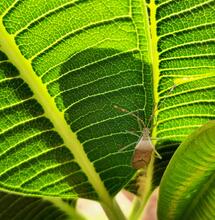F1 Fast Version Genetics - Discovery, breeding and advantages

Manolo of Sweet Seeds told us about F1 Fast Version strains, how they were discovered and what their advantages are.
Cannabis has two flowering patterns. Classical strains are photo-dependent, meaning that they start to flower as hours of light diminish. Conversely, autos do so depending on their age, without being influenced by the photoperiod. F1 Fast Version strains are photo-dependent with a part of auto-flowering plant genes in their genetics which do not appear in the offspring, but contribute to bring the harvest date forward.
F1 Fast Version and Mendel’s laws
An F1 hybrid, also called “a commercial seed” is made by crossing two different pure lines. The main characteristics of this hybrid are the uniformity of traits and the typical hybrid strength. According to Mendel’s first law of inheritance, the first filial generation (F1) is homogeneous and similar to the parent carrying the dominant allele. The second law says that the second filial generation (F2), which is obtained from crossing the first generation, is 50% similar to the first generation genotype, 25% similar to the dominant genotype and 25% similar to the recessive genotype.
The third law pertains to the independence in the transmission of hereditary traits, in other words the inheritance of a specific genetic trait does not affect the inheritance of another genetic trait. In the F1 Fast Version line, the three laws apply, i.e. this is a typical form of Mendelian inheritance, as a single gene determines the type of flowering. Auto-flowering lines contain two alleles of the recessive auto-flowering trait, this means that this trait manifests itself when two alleles transmitting it combine together. Photo-dependent lines contain two alleles of a dominant photo-dependent flowering trait. The only exception are F1 Fast Version lines, where a dominant allele transmits photo-dependence to the full offspring and another recessive allele transmits auto-flowering but does not manifest itself.
This is due to the fact that F1 Fast Version strains result from the combination of a photo-dependent parent and an auto-flowering parent. Again, in accordance with the first Mendel’s law, the full offspring is homogeneous and resembles the dominant parent, which is why they all present the photo-dependence trait but contain both traits. The presence of the auto-flowering trait does not manifest itself in the phenotype but is however influential as it makes flowering and ripening quicker. When two F1 Fast Version plants are crossed, their offspring are split into 50% F1 Fast Versions, 25% autos and 25% conventional photo-dependent individuals.
That is why, in order to achieve an F1 Fast Version, a photo-dependent parent always has to be combined with another auto-flowering parent and plants of this type only appear in the first generation resulting from this cross. There are many types of auto-flowering strains. A few have a long-lasting flowering period but are uninteresting for end users as the cultivation period of this type is as long as that of photo-dependent strains. The most popular auto-flowering strains start flowering at day 21 to 28 from germination and complete flowering after 5 weeks or so, meaning they are ready for harvest at week 8 or 9. In F1 Fast Version, this rapidity is inherited by the offspring. Flowering in this offspring is slower compared to autos, but quicker compared to photo-dependent plants.
Auto-flowering breeding experience
In 2007 Sweet Seeds started to work with auto-flowering genetics and in 2009 presented the first auto-flowering strains to the public. In addition to the classical Lowryder of the Joint Doctor’s seed bank, they used other genetic lines, chiefly the first lines produced by Lowlife Seeds, or various lines from northern Canada or the northern USA, most probably crosses of Ernest Small or Mighty Mite from British Columbia.
In scientific literature, the phenomenon of auto-flowering is unexplained but, after analysing the inheritance of this trait and various experiments, scientists came to the conclusion that the auto-flowering trait is transmitted by a single gene, possibly a mutant photo-dependent flowering gene that has since ancient times remained in the cannabis genetic pool. This mutation is beneficial in particularly cold places, where it is appropriate for wild cannabis to complete flowering and produce useful seeds before the arrival of autumn. In places such as northern Canada or the northern USA, characterised by a harsh climate, large quantities of hemp were grown in the past and these crops were abandoned for various reasons. As these formerly domesticated strains were left free to grow wild, this gene is likely to appear again. When it does, it implies an adaptive advantage for plants with this auto-flowering trait in cold places. After a short amount of time, Sweet Seeds realised that these genotypes, which consumers did not like for their unattractive taste or size, had a great potential if they underwent genetic improvement.
So they started to select these primitive auto-flowering strains by crossing them with their favourite elite clones. When auto genotypes were crossed with photo-dependent elite clones, no auto-flowering specimens appeared in the first generation, in strict accordance with Mendel’s law, and the entire offspring was homogeneous and resembled the dominant photo-dependent parent. They had to wait until the next generation to observe a segregation of genotypes and, consequently, the appearance of 25% autos. When the second-generation autos were crossed with each other, the auto trait manifested itself in the entire offspring. The third Mendel’s law defines the independence of hereditary traits. So, although the auto-flowering trait stabilises in the third-generation, the offspring may occasionally present tastes and psychoactive characteristics inherited from photo-dependent parents. In this way, strains of increasingly better quality can be obtained while retaining the auto-flowering trait.
F1 Fast Version discovery and breeding experience
In the first tests made with autos, while the Cream Caramel Auto improvement programme was being conducted, Manolo observed that the first generation had no auto trait, but its flowering was shorter. Initially he double-checked the notes he had written on his timetable for a possible error and made a second attempt - but results were unchanged, i.e. the flowering time was shorter. He acknowledged, therefore, this characteristic in the first-generation cross between a photo-dependent and an auto-flowering individual. After creating Cream Caramel Auto, the seed bank started to work towards the same direction with other strains and the same results appeared. So Sweet Seeds decided to add F1 Fast Version ® strains to their catalogue and register the trademark. F1 Fast Version strains are F1 hybrids, i.e. they are invariably the first generation created by crossing a photo-dependent with an auto genotype.
As no auto parents can be kept in the form of clones, this means that the quality of plants can only improve. Indeed, if the breeding and selection process is correctly carried out with the best parents in each generation, the strain will evolve depending on which parents are selected. To sum up, F1 Fast Version plants are continuously evolving and their development is linked to the progress of the auto parent. When an auto line is correctly selected, the F1 Fast Version line will also be improved. In actual fact, the F1 Fast Version is a rapid form of improved and selected elite clones, which makes it possible to have a clone version that flowers in advance, has the typical hybrid strength and makes the selection of other interesting traits possible. Apart from their breeding work, Manolo also told us about their 4-year collaboration with an official plant biotechnology centre, and the significant sums invested in this partnership. In any case, they are convinced that research also implies a risk element and investments are made without knowing whether the expected outcome will be achieved.
Advantages of F1 Fast Version
The short flowering trait strengthens with each generation obtained from auto parents, as the very best specimens of each family are chosen as parents at the time of the selection, with emphasis put on the individuals with a rapid flowering trait to be transmitted to the next generation. A quick harvest means that the inconvenience of fungi caused by the wet and rainy autumn weather can be avoided. In addition to a shorter flowering period, F1 Fast Version plants have the classical strength of F1 hybrids, which can be observed, e.g., in Green Poison F1 Fast Version, a strain with a higher yield and strength than that of the classical photo-dependent version, and with the further opportunity to harvest it in late August to early September outdoors.
Green Poison F1 Fast Version is a very rapid Skunk and flowers at week 6 or 7. What is more, it yields large quantities of sticky buds, with an intense smell, and it is easy to grow. Another advantage of F1 Fast Version plants resides in their photo-dependent trait. For this very reason, they can be kept as mothers in the form of cuttings of the best plants, whereas the production process has to always start from seeds in autos. These strains allow growers to plan their plant size and yield. So, if they wish to obtain tall plants, they only need to plant them in advance for them to have a longer growing period or, in indoor crops, to continue the growth photoperiod until the plants have reached the desired size.
Conclusions
As Manolo puts it, the launch of the F1 Fast Version line was an astounding success. “When I first discovered this line, I thought about the advantages it implied for growers, as it could make a real difference, but was not sure about how it would be received. Although there was no explosion in demand, as we saw when we first introduced autos, consumers are more and more attracted year after year. As the saying goes, time is gold. Growers who first try it are satisfied and tend to replant it. Other seed banks are starting to offer rapid lines of this type. In our catalogue, we have expanded the F1 Fast Version family to 10 strains, and there are more to come this year. This introduction period is very positive, we have diversified our offer and consumers are now appreciating products with a shorter flowering period and replant them in the next season. These strains are particularly useful for growers living in cold or wet regions. In any case, results are excellent in all climates. Growers in warm areas also use F1 Fast Version to harvest and exploit plants earlier. Another appreciated advantage is the typical vigour of these plants making them suitable for both indoor and outdoor crops.”
H. Madera / Pictures: Jaypp



.png)